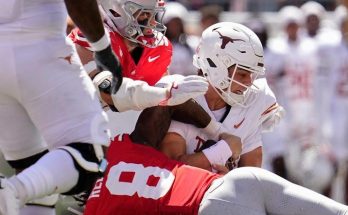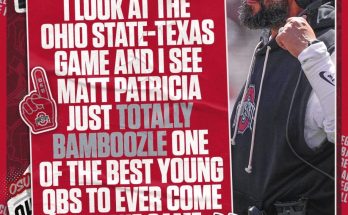The Indiana Pacers have been thrust into a pivotal moment this season, a juncture where leadership and resilience must rise from within the team’s own ranks. With Tyrese Haliburton sidelined for the remainder of the season due to injury, the franchise faced a critical question: who will now steer the ship? The answer, unequivocally, is Andrew Nembhard. The Pacers’ general manager, Chad Buchanan, did not mince words when he addressed the media, emphasizing the organization’s faith in Nembhard’s ability to take the reins. “We’re asking him to run our team… be more assertive as a scorer… we believe in him,” Buchanan said. These words are not just a vote of confidence; they are a clear mandate and a challenge for a young player stepping into a much bigger role.
Understanding the significance of this transition requires delving deeper into Andrew Nembhard’s journey, his style of play, and what it means for the Pacers moving forward. More broadly, it also invites an exploration of what it takes for any player to evolve from a role player into a bona fide leader on an NBA team. This is a narrative not only about basketball skills but also about mental fortitude, adaptability, and the growth necessary to fill the void left by an indispensable teammate like Haliburton.
Andrew Nembhard’s rise to this moment is a story of perseverance and steady improvement. Drafted in the second round of the 2022 NBA Draft by the Indiana Pacers, Nembhard entered the league without the fanfare of a lottery pick or a highly touted prospect. His collegiate career, notably at Florida and then Gonzaga, showed flashes of a versatile guard capable of controlling the tempo and making smart decisions, but the NBA stage is a different beast altogether. His rookie season was about acclimating to the pace, physicality, and complexity of professional basketball. But with Haliburton’s injury, the door has opened for Nembhard to showcase a more assertive version of himself.
The challenge of stepping into a leadership role mid-season, especially under the shadow of a key player’s injury, cannot be overstated. The Pacers have relied on Haliburton as their primary playmaker, the player who initiates offense, orchestrates the team’s movement, and frequently takes responsibility during crunch time. Losing such a player disrupts a team’s rhythm and forces others to fill roles they might not have been fully prepared to assume at the outset of the season. Buchanan’s statement indicates the team’s readiness to support Nembhard as he embraces this new responsibility. It also signals a strategic pivot: the Pacers need Nembhard not just to run the offense but to become a more confident scorer.
Scoring assertively in the NBA, especially as a guard, demands a blend of confidence, skill, and basketball IQ. For a player like Nembhard, whose game is often defined by his vision and passing, developing that scoring mindset involves shifting gears mentally. He must recognize when to be aggressive, when to attack the rim, and when to pull up for a jumper, all while balancing the flow of the offense. It requires an acute understanding of how defenses adjust to him and how to exploit those adjustments. This evolution will be crucial if the Pacers are to remain competitive in a league where scoring threats are abundant and defensive pressure intense.
Leadership in basketball extends beyond just physical abilities and statistics. It encompasses the intangible qualities that inspire teammates, maintain morale, and cultivate a culture of resilience. Nembhard’s opportunity is not just about putting points on the board or dishing assists; it’s about being a stabilizing presence on and off the court. This means being vocal, setting the tone in practice, holding teammates accountable, and making the right decisions under pressure. Given his age and experience level, this is a significant developmental leap, but one that the Pacers clearly believe he can make.
The broader context here is also critical. The Indiana Pacers are at a crossroads in their franchise timeline. After years of fluctuating success and roster transitions, they are now aiming to build a sustainable core capable of contending in the Eastern Conference. Haliburton was viewed as a cornerstone of that rebuild, a dynamic young guard with elite playmaking skills. His injury is a setback, but it is also an opportunity for the team to see who else can step up and contribute. Nembhard’s ascension is part of that process — a test of depth, development, and adaptability.
From a tactical standpoint, the Pacers’ coaching staff will need to tailor their offensive schemes to maximize Nembhard’s strengths while easing his transition into a primary role. This might mean giving him more freedom to initiate plays, adjusting pick-and-roll usage, or designing sets that allow him to exploit mismatches. Additionally, the team may look to surround him with complementary players who can space the floor and provide reliable scoring options. This support system is vital because while leadership on the court is essential, basketball remains a team sport that requires cohesion and chemistry.
Nembhard’s skill set lends itself well to this challenge. He is known for his passing ability, court vision, and steady decision-making. These attributes make him a natural floor general, someone who can read defenses and find teammates in advantageous positions. What he now needs to develop further is the scoring dimension — the ability to create his own shot consistently and to be aggressive without forcing plays. This balance will determine how successful he is in this expanded role.
Confidence is often the hidden variable in a player’s development. When an opportunity like this arises, the player must seize it with belief in their abilities. For Nembhard, the encouragement from the front office and coaching staff is a powerful boost, but ultimately the confidence must come from within. It involves trusting one’s preparation, training, and instincts. It also means embracing mistakes as part of the learning curve, rather than shying away from responsibility.
The fans’ perspective is also worth considering. Supporters of the Pacers have been eagerly watching the team’s young players grow and hoping for a breakthrough season. With Haliburton’s injury, there is naturally concern about the team’s prospects. But many will be rooting for Nembhard to rise to the occasion, knowing that sometimes a team’s identity and character are forged through adversity. His success could become a defining narrative for this season and potentially the franchise’s future.
Historically, the NBA is filled with examples of players who stepped up unexpectedly and changed the trajectory of their careers and teams. When a star goes down, it often creates space for emerging talents to prove themselves. Sometimes these moments reveal hidden leadership qualities and untapped potential. The Pacers are banking on Nembhard being one of those players — someone who can not only fill the void temporarily but who might emerge as a foundational piece in the long term.
For Nembhard, the path ahead will not be without challenges. He will face tougher defenses, more physical scrutiny, and higher expectations. Opponents will study him more closely, looking to exploit any weaknesses. Managing the physical and mental demands of a larger role will require discipline and resilience. But with the right mindset and support, these obstacles can become opportunities for growth.
The psychological aspect of becoming a team leader cannot be underestimated. Nembhard will need to cultivate a sense of calm under pressure, develop emotional intelligence to connect with teammates, and demonstrate a relentless work ethic that sets an example. Leadership also means accepting criticism constructively and constantly striving to improve. These qualities are often as important as any physical skill on the court.
From a developmental perspective, the Pacers’ coaching staff will likely work closely with Nembhard to refine his offensive repertoire. This might include enhancing his shooting mechanics, expanding his shot selection, and improving his ability to finish through contact. On the defensive end, becoming a leader also means setting the tone with energy and communication, helping organize team defense, and leading by example.
This transition period for the Pacers can also be viewed through the lens of team dynamics. The loss of a key player can sometimes fracture a team’s chemistry, but it can also unite the group around a common goal. Nembhard’s role as a leader means fostering trust and cohesion among teammates, encouraging collaboration, and reinforcing a culture where everyone contributes. This environment is essential for sustained success.
Financially and strategically, giving Nembhard this opportunity also signals the organization’s commitment to developing talent from within rather than relying solely on trades or free agency. It reflects a long-term vision centered around player growth and identity. If Nembhard rises to the occasion, it could validate the team’s scouting and development processes.
In practical terms, the immediate impact of Nembhard taking control of the offense will be measured by several metrics: points per game, assists, turnovers, shooting efficiency, and plus-minus ratings, among others. But beyond statistics, it’s the intangible leadership qualities, the ability to command respect, and the steadiness in high-pressure moments that will truly define his success.
Fans and analysts will be watching closely to see how Nembhard handles this increased responsibility game after game. His performance will likely influence the team’s overall results and could shape offseason decisions around roster construction. If he thrives, the Pacers might build more around his style and strengths, tailoring their identity to suit his skill set.
It’s also important to highlight the role of veteran players and coaches in supporting Nembhard’s development. Mentorship from experienced teammates can ease the burden of leadership, providing guidance and helping manage the mental toll. The coaching staff’s ability to communicate clear expectations and offer constructive feedback will be crucial in this transition.
In summary, the keys now belong to Andrew Nembhard, and with that comes an enormous responsibility and opportunity. The Pacers’ future this season depends heavily on his ability to embrace a leadership role, become a more assertive scorer, and guide the team through adversity. The organization’s confidence in him is a strong vote of belief that he has the tools and character to succeed. His journey from a supporting player to the team’s floor general embodies the essence of growth, resilience, and the unpredictable nature of professional sports. As the season progresses, Nembhard’s performance will not only impact the Pacers’ immediate fortunes but also shape the narrative of a young player stepping up when the moment demanded it most.
This moment in Indiana is a powerful reminder of how opportunities can arise unexpectedly and how readiness, both mentally and physically, is essential for seizing them. It’s a story that transcends basketball — about leadership, adaptation, and the courage to embrace change. Andrew Nembhard’s chapter in this ongoing saga is just beginning, and all eyes will be on him as he takes hold of the keys and drives the Pacers forward.



